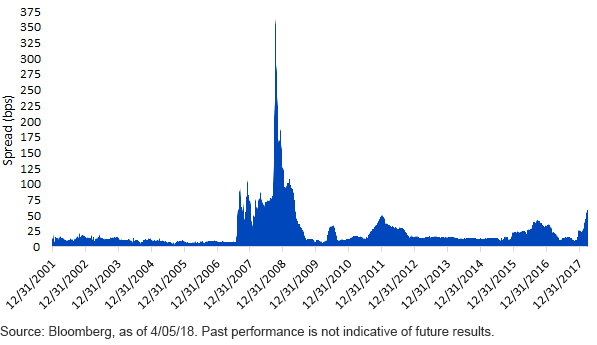Market Watch: LIBOR Is Back in the News


In late December, I wrote a piece, “LIBOR’s Fate: Could It Be Real This Time?,” about the announcement last summer that this widely used borrowing benchmark would be discontinued at the end of 2021. Well, LIBOR is back in the news, but this time for a different reason. Given the influx of questions I’ve received in the last couple of weeks, I thought it would be a good idea to share some thoughts.
The headlines this time around have nothing to do with LIBOR’s fate but, rather, its noteworthy move to the upside in a very short period of time. Certainly, the direction of three-month LIBOR can be affected by Federal Reserve (Fed) actions, and, in this case, the policy makers did implement another 25 basis point (bps) increase in the Fed Funds Rate at last month’s FOMC meeting. While this rate hike may help to explain some of the increase since year-end, it is only part of the story, as the three-month LIBOR rate actually has risen 63 bps thus far in 2018. If you go back to the end of September, the increase has been roughly 100 bps, with the cumulative Fed rate hikes representing 50 bps since then, or only half of the overall rise.
Three-Month LIBOR–OIS Spread

Naturally, that raises the issue of what other forces could be at work here. Perhaps the most important factor lies in the U.S. Treasury’s financing needs. As Treasury’s borrowing requirements began to surge for fiscal year 2018 (and for the next few years beyond), the nation’s debt managers needed to utilize Treasury’s basically full arsenal of bills, notes and bonds to meet the burgeoning task at hand. Typically, t-bills are the workhorse in such instances. These instruments are used to address the changing financing needs of the federal government, and, given their short-term nature and the weekly auction schedule for the one, three and six-month maturities, Treasury turns to the bill sector for more-effective debt management.
Connecting the dots, t-bill issuance has surged of late, pushing short-term funding costs, such as the three-month LIBOR, up as a result. Let’s get some perspective. Thus far in fiscal year 2018, the amount of t-bills outstanding has risen by $487.0 billion, with nearly 70% of this total, or $333.0 billion, occurring between January and March. For all of fiscal year 2017, the increase was pegged at $155.0 billion.
The money and bond markets’ focus has been on three-month LIBOR–OIS spread. We know LIBOR is a key borrowing benchmark rate. OIS (overnight indexed swap) is an interest rate swap that consists of both a fixed and a floating rate component. The floating rate part uses an overnight rate index (in the case of the U.S. dollar, the Federal Funds Rate), while the fixed portion is set at an agreed-upon rate between the two parties. Thus, the OIS is considered a proxy for Fed Funds. The LIBOR–OIS spread itself represents the difference between these two instruments and measures, one that could contain potential credit risk (LIBOR) versus one that essentially does not (Fed Funds).
When this spread widens, it is considered to be a sign that there are stresses in the short-term bank funding markets. This differential has been on a sharp upward trajectory since mid-November, rising by nearly 50 bps to 59 bps, as of this writing. This is the widest spread since 2009. One of the questions I’ve been getting is: Does the recent widening in this spread signal any stresses? While the level has surpassed the highs of the eurozone crisis in 2012, it pales in comparison to the 364 bps peak during the financial crisis.
Conclusion
In my opinion, the widening in the three-month LIBOR–OIS spread is not signaling stresses, as investors witnessed almost 10 years ago. However, it does reveal tighter financial conditions, beyond the Fed rate hikes that currently are in place. In the near term, the spread could ease up a bit, as a drop in t-bill issuance due to the tax season works its way through the system. Indeed, as of this writing, Treasury already has announced cutbacks of $10.0 billion for the four-week bill and $3.0 billion each for the three- and six-month maturities. That being said, the size and scope of the Treasury’s financing needs more than likely keeps the “LIBOR story” in the headlines.
Unless otherwise stated, all data is from Bloomberg as of April 6, 2018.


